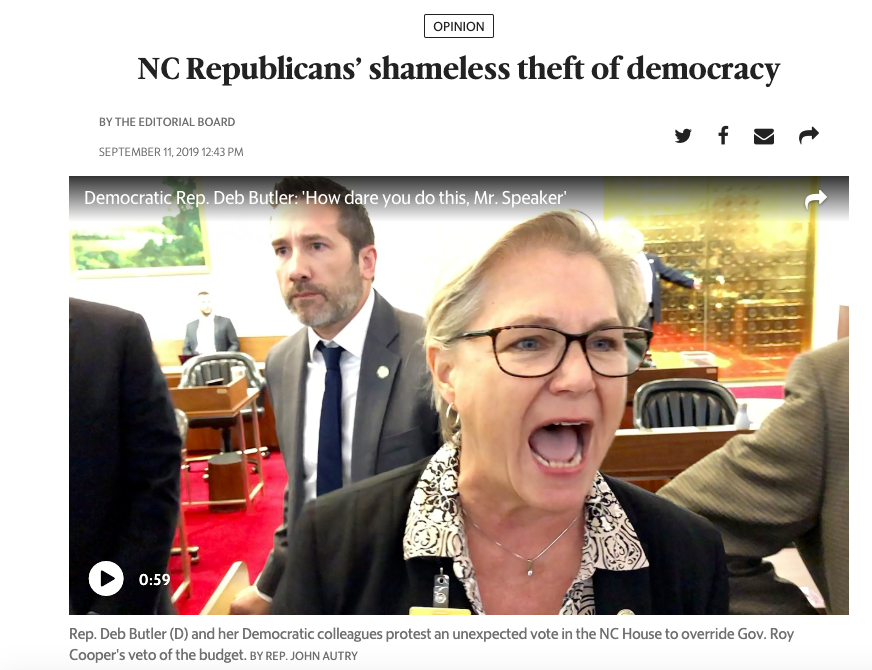When Raleigh News & Observer Associate Opinion Editor Ned Barnett and his boss, Peter St. Onge, were tipped off to a political dirty trick that was playing out at the state Capitol, they didn’t wait for the newsroom to publish a story.
While reporters rushed to contact sources and break the news, the opinion team jumped into action as well, confirming details and quickly beginning work on a scathing editorial decrying the Republican House Speaker’s secret plan to ram through a consequential veto override when most Democratic lawmakers were absent. By noon, Barnett and St. Onge, the North Carolina Opinion Editor for McClatchy, were ready to publish an editorial declaring that the Republican “connivers” in the legislature were “beyond shame.”
Reader interest in the news was peaking, and Barnett’s incisive and insightful commentary quickly caught fire online, eventually becoming Raleigh’s most-read editorial to date.

Published Sept. 11, 2019, this editorial highlights McClatchy’s new approach to opinion journalism that is digital-first, breaks news and takes a bold stance on local issues.
With their fast metabolism, strong news judgment and digital-first approach, St. Onge and Barnett highlighted how opinion journalism can and should attract more readership and drive digital subscriptions in our news organizations.
Now, with the announcement of a new initiative, McClatchy is making a bet on the value of high-quality opinion journalism and its essential role in attracting and retaining loyal readers. The company, which includes 30 news organizations, is creating a single opinion structure that will deliver high-impact, community-focused journalism and a better return on audience and digital subscription conversions.
Previously, opinion editors, opinion writers and local columnists had been scattered across McClatchy with a hodge-podge of reporting lines and an array of directives and strategies. Now, all opinion journalists in our newsrooms will work directly with and report up to me in my role as National Opinion Editor.
As we work to make better use of our collective opinion firepower, we’ll develop and implement best practices for opinion journalism and grow our audience by delivering editorials and columns that readers are willing to pay for.
This innovative effort will preserve and prioritize local opinion journalism while sharing our best ideas for reinvented editorial boards across the company. McClatchy opinion journalists will still regularly consult with their newsroom editors and will focus intensely on local and state issues, while providing readers with unique commentary they can’t find anywhere else.
Opinion journalists play an important role in our communities, and losing our news organizations’ editorial voices would leave a void in the cities that we cover. But McClatchy’s opinion initiative is not simply a high-minded mission. It’s also a carefully considered strategy.
Our expectation is that high-quality, locally focused opinion journalism will play a central role in our news organizations’ success. And my objective is to show that McClatchy’s commitment to opinion journalism will yield a significant return on this investment.
Of course, many other news organizations have cut or entirely eliminated their editorial boards, publishing stripped-down opinion pages that primarily consist of syndicated columns and a smattering of letters to the editor. Less-than-impressive audience numbers and concerns about controversial commentary turning off readers have made opinion journalists an endangered class in numerous newsrooms.
But in McClatchy, we’ve found that an updated approach to opinion writing — one that’s focused on original reporting, local commentary and timely editorials and columns — can attract more readers and help turn them into subscribers. Analytics also tell us that our current subscribers read staff-written opinion journalism in large numbers. So, we’ve implemented strategies that minimize the amount of time our opinion journalists spend on legacy print-focused tasks, allowing them to write more editorials and columns that make an impact.
I arrived in Kansas City two-and-a-half-years ago facing both a daunting and a thrilling challenge: Rebuild The Kansas City Star Editorial Board from the ground up. Tony Berg, who was The Star’s publisher, and Mike Fannin, the editor, launched what many viewed as a bold experiment, investing in more opinion journalists at a time when many editorial boards across the country were shrinking rapidly.
Their decision to zig when it seemed that everyone else was zagging has paid dividends. Readership for The Star’s opinion journalism has increased substantially, and our analytics tell us that opinion journalism is playing a significant role in converting readers into subscribers.
In Kansas City, we’ve hired opinion journalists with reporting chops who deliver editorials and columns that go far beyond commenting on already-reported news. Our team has made accountability journalism and original reporting central features of our work, advocating for transparency and good government while calling out bad actors in both political parties.
Kansas City Star Editorial Board members are digital creatures who shoot and edit video and focus on when their editorials and columns will publish online — not when or even if their work will see the light of newsprint. We’ve certainly made mistakes along the way, but we’ve learned from our failures (Hint: Editorials about holidays, anniversaries or any annual event that you’ve always covered and couldn’t possibly skip this year aren’t attracting any readers.) And we’ve approached analytics as a trove of information that can help us write better headlines, optimize our publishing schedule and understand our audience.
Now, as we expand these opinion efforts company-wide, our goal is to reimagine editorial boards across McClatchy, letting go of traditional print-focused “must-dos” and developing best practices for opinion journalists with a digital metabolism. The time when editorial writers could follow up on news stories a couple days later and just add the outrage or an “attaboy” is a distant memory.
Original reporting is an essential component of high-impact opinion journalism, as is unique content that readers can’t find elsewhere. Simply adding to the cacophony of Trump commentary in the digital universe isn’t a winning strategy for local news organizations.
With that in mind, our journalists will be focusing on several guiding principles aimed at growing readership for opinion journalism in McClatchy:
- Be aggressive: Break news in editorials and columns. Write strong “call to action” editorials. If the newsroom has already reported on an issue, find a way to advance the story or develop a new angle. Tell readers something they don’t know.
- Be timely: Move at the speed of news and ride the wave of reader interest and attention. Don’t write on a print schedule.
- Be local: Focus on issues that hit close to home for our audiences. Readers aren’t coming to The Kansas City Star Editorial Board for our thoughts on the State of the Union address. Our original reporting and commentary on corrupt local officials or misspent tax dollars or even the rooftop dog park that saw multiple pups fall to their deaths will attract more loyal readers — and have a bigger impact on public policy. (Sadly, the dog park tragedy is a true story.)
- Be experimental: Reach new audiences by trying different approaches that go beyond editorials, columns and letters to the editor that all fit neatly on the print page. Interview newsmakers on Facebook Live. Or shoot video of candidate endorsement interviews. Should you launch a podcast? Could community events generate revenue or new subscriptions? Experiment, fail fast and let go of what’s not working.
By building this McClatchy opinion team, we’re making a commitment to timely local opinion journalism with the clear expectation that this intense focus on proven, opinion-specific strategies will help convert more readers into subscribers. Stay tuned.
Colleen McCain Nelson is opinion editor at McClatchy and editorial page editor and vice president of the Kansas City Star. She can be reached by email at cnelson@kcstar.com. This essay is part of a body of work on reimagining opinion journalism.
Share with your network
Reimagining Opinion Journalism
You also might be interested in:
Reaching younger audiences has long been a challenge for media organizations. As platforms evolve, trust in news shifts and news avoidance grows, it can feel especially difficult to connect with and serve multigenerational audiences in an authentic and sustainable way. How can news leaders do their part to represent and include community perspectives from members of different age groups?
For us, we knew one of our biggest hurdles to success would be challenging the assumptions, both spoken and unspoken, we held for others. Here’s what we’ve learned over the past three years of gathering multigenerational problem-solvers.
Generational tension has always existed, of course, but today it is amplified by several factors, both in our communities and our newsrooms. We asked five summit participants to share more about the ways they are engaging and serving multigenerational audiences.




